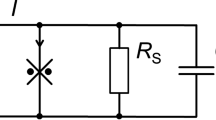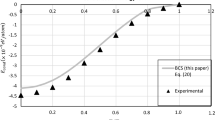Abstract
Quantum criticality is associated with a system composed of a nearly infinite number of interacting quantum degrees of freedom at zero temperature, and it implies that the system looks on average the same regardless of the time- and length scale on which it is observed. Electrons on the atomic scale do not exhibit such symmetry, which can only be generated as a collective phenomenon through the interactions between a large number of electrons. In materials with strong electron correlations a quantum phase transition at zero temperature can occur, and a quantum critical state has been predicted1,2, which manifests itself through universal power-law behaviours of the response functions. Candidates have been found both in heavy-fermion systems3 and in the high-transition temperature (high-Tc) copper oxide superconductors4, but the reality and the physical nature of such a phase transition are still debated5,6,7. Here we report a universal behaviour that is characteristic of the quantum critical region. We demonstrate that the experimentally measured phase angle agrees precisely with the exponent of the optical conductivity. This points towards a quantum phase transition of an unconventional kind in the high-Tc superconductors.




Similar content being viewed by others
References
Varma, C. M., Nussinov, Z. & van Saarloos, W. Singular or non-Fermi Liquids. Phys. Rep. 361, 267–417 (2002)
Sachdev, S. Quantum Phase Transitions (Cambridge Univ. Press, Cambridge, 1999)
Saxena, S. S. et al. Superconductivity on the border of itinerant-electron ferromagnetism in UGe2 . Nature 406, 587–592 (2000)
Tallon, J. L. & Loram, J. W. The doping dependence of T*—what is the real high-T c phase diagram? Physica C 349, 53–68 (2001)
Orenstein, J. & Millis, A. J. Advances in the physics of high-temperature superconductivity. Science 288, 468–474 (2000)
Kaminski, A. et al. Spontaneous breaking of time-reversal symmetry in the pseudogap state of a high-Tc superconductor. Nature 416, 610–613 (2002)
Mook, H. A. et al. Magnetic order in YBa2Cu3O6+x superconductors. Phys. Rev. B 66, 144513 (2002)
Quijada, M. A. et al. Anisotropy in the ab-plane optical properties of Bi2Sr2CaCu2O8 single-domain crystals. Phys. Rev. B 60, 14917–14934 (1999)
Puchkov, A. V., Basov, D. N. & Timusk, T. The pseudogap state in high-Tc superconductors: An infrared study. J. Phys. 8, 10049–10082 (1996)
Santander-Syro, A. F. et al. Absence of a loss of in-plane infrared spectral weight in the pseudogap regime of Bi2Sr2CaCu2O8+δ . Phys. Rev. Lett. 88, 097005–097008 (2002)
Littlewood, P. B. & Varma, C. M. Phenomenology of the normal and superconducting states of a marginal Fermi liquid. J. Appl. Phys. 69, 4979–4984 (1991)
Prelovsek, P. On the universal optical conductivity and single-particle relaxation in cuprates. Europhys. Lett. 53, 228–232 (2001)
Ioffe, L. B. & Millis, A. J. Zone-diagonal-dominated transport in high-T c cuprates. Phys. Rev. B 58, 11631–11637 (1998)
Schlesinger, Z. et al. Superconducting energy gap and normal-state conductivity of a single-domain YBa2Cu3O7 crystal. Phys. Rev. Lett. 65, 801–804 (1990)
El Azrak, A. et al. Infrared properties of Yba2Cu3O7 and Bi2Sr2Can-1CunO2n+4 thin films. Phys. Rev. B 49, 9846–9856 (1994)
Molegraaf, H. J. A., Presura, C., van der Marel, D., Kes, P. H. & Li, M. Superconductivity-induced transfer of in-plane spectral weight in Bi2Sr2CaCu2O8+δ . Science 295, 2239–2241 (2002)
Li, M., van der Beek, C. J., Konczykowski, M., Menovsky, A. A. & Kes, P. H. Superconducting properties of strongly underdoped Bi2Sr2CaCu2O8+x single crystals. Phys. Rev. B 66, 024502 (2002)
Anderson, P. W. Infrared conductivity of cuprate metals: Detailed fit using Luttinger-liquid theory. Phys. Rev. B 55, 11785–11788 (1997)
Bernhoeft, N. An analysis of the dynamical magnetic susceptibility in non-Fermi liquids. J. Phys. Condens. Matter 13, R771–R816 (2001)
van der Marel, D. Anisotropy of the optical conductivity of high Tc cuprates. Phys. Rev. B 60, R765–R768 (1999)
Liu, Y. & Goldman, A. M. Superconductor-insulator transitions in two dimensions. Mod. Phys. Lett. B 8, 277–309 (1994)
Fisher, M. P. A., Grinstein, G. & Girvin, S. M. Presence of a quantum diffusion in two dimensions: Universal resistance at the superconductor-insulator transition. Phys. Rev. Lett. 64, 587–590 (1990)
Damle, K. & Sachdev, S. Nonzero-temperature transport near quantum critical points. Phys. Rev. B 56, 8714–8733 (1997)
Tajima, S., Gu, D. G., Miyamoto, S., Odagawa, A. & Koshizuka, N. Optical evidence for strong anisotropy in the normal and superconducting states in Bi2Sr2CaCu2O8+z . Phys. Rev. B 48, 16164–16167 (1993)
Aspnes, D. E. Approximate solution of ellipsometric equations for optically biaxial crystals. J. Opt. Soc. Am. 70, 1275–1277 (1980)
Acknowledgements
We thank C. M. Varma, P. Prelovsek, C. Pepin, S. Sachdev and A. Tsvelik for comments during the preparation of this work, and N. Kaneko for technical assistance. This investigation was supported by the Netherlands Foundation for Fundamental Research on Matter (FOM) with financial aid from the Nederlandse Organisatie voor Wetenschappelijk Onderzoek (NWO). The crystal growth work at Stanford University was supported by the Department of Energy's Office of Basic Energy Sciences, Division of Materials Science.
Author information
Authors and Affiliations
Corresponding author
Ethics declarations
Competing interests
The authors declare that they have no competing financial interests.
Rights and permissions
About this article
Cite this article
Marel, D., Molegraaf, H., Zaanen, J. et al. Quantum critical behaviour in a high-Tc superconductor. Nature 425, 271–274 (2003). https://doi.org/10.1038/nature01978
Received:
Accepted:
Issue Date:
DOI: https://doi.org/10.1038/nature01978
- Springer Nature Limited
This article is cited by
-
Fermi liquid-like behaviour of cuprates in the pseudogap phase simulated via T-dependent electron-boson spectral density
Scientific Reports (2023)
-
Reconciling scaling of the optical conductivity of cuprate superconductors with Planckian resistivity and specific heat
Nature Communications (2023)
-
Signature of quantum criticality in cuprates by charge density fluctuations
Nature Communications (2023)
-
Microscopic theory of novel pseudogap phenomena and Bose-liquid superconductivity and superfluidity in high-\(T_c\) cuprates and other systems
Pramana (2023)
-
Hydrodynamic approach to two-dimensional electron systems
La Rivista del Nuovo Cimento (2022)





